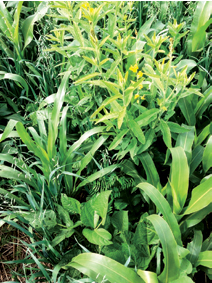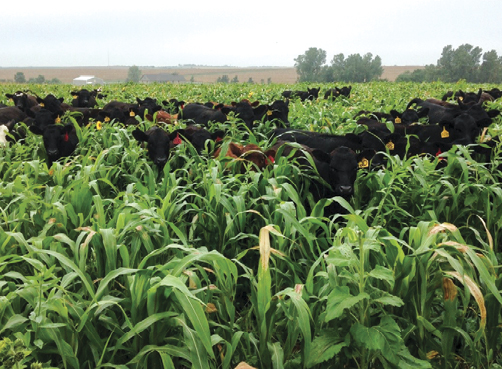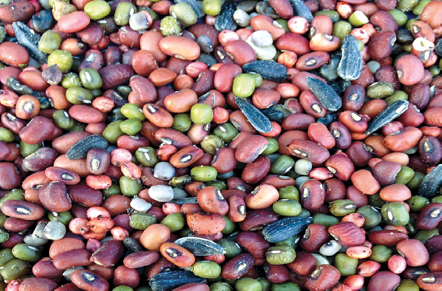Pictured Above: FULL COVERAGE. A self-described “cover crops addict,” Bill Buessing maintains a cash crop or cover-crop mix on every acre of his farm year-round. Not only does this protect and improve the soil, it also provides forage for his cattle and has allowed the Axtell, Kan., no-tiller to cut back on fertilizer.
While growers across the U.S. are experimenting with integrating cover crops into their rotations as a source of livestock forage, few do it with as much flair as Bill Buessing.
A self-described “cover crops addict,” the Axtell, Kan., no-tiller maintains a cash crop or cover- crop mix on every acre of his farm year-round. Buessing also seeds an experimental plot each year, testing more than 40 different types of cover crops and blends. He puts the results to work for both his traditional cash crops and a growing cattle herd.
He says covers let him reduce nutrient runoff, retain and utilize more water, slow down wind erosion, help with weed control, build organic matter in the soil, recycle nutrients, feed cattle and build nitrogen (N) for present and future crops.
But, he adds, achieving maximum results requires more than simply adding another planting to a farmer’s rotation. No-tillers must learn how to manage crops more intensely, as well as document how variations in cover-crop blends and practices affect yield and soil health long-term.
“You have to change your mindset if you’re going to make cover crops work,” he says. “Implementing cover crops is a process that does not always show immediate rewards.”
Cereal Rye Workhorse
Utilizing a secondary crop for livestock feed is not new to Buessing’s family operation. His father drilled oats into wheat stubble for fall pasture, and when Buessing purchased his first farm in 1998 he did the same where soybeans weren’t double-cropped behind wheat.
“Cereal rye does a lot for your soil. It’s the closest thing to a silver bullet we have found...”
But with two brothers also farming, Buessing says his father — who is still active in the operation himself — encouraged all three of them to branch out from his farming model.
“Dad encouraged us to think for ourselves and make our own decisions when we started farming,” Buessing says.
For Buessing, the integration of cover crops was more than an experiment — it was a necessity. For 19 years, he worked as a lineman for the Nemaha Marshall Electric Cooperative by day and tended to his farm and cattle after hours. But as his oldest daughter approached high school, his wife Sandy challenged him to find a new way to both farm and spend more time with family.

SOLAR CROP PANELS. Bill Buessing says the wide leaves catch more sunlight and build carbon that can be utilized by subsequent corn or soybean crops. The large canopy also helps suppress weed growth.
With 440 acres, a smaller-than- average farm size in Marshall County, Buessing weighed how to increase profitability enough to justify leaving a full-time, off-farm job. The answer: Planting cover crops as forage.
“I don’t farm enough acres to farm full-time without cover crops or livestock,” he says.
Buessing began seeding covers for winter forage in 2003. In 2007, he seeded cereal rye specifically as a cover crop, after corn and ahead of soybeans. He uses a Landoll drill to seed his cover crops.
“Cereal rye does a lot for your soil,” he says. “It’s the closest thing to a silver bullet that we have found.”
He explains that cereal rye, which he typically seeded around 50-60 pounds per acre, has the biggest root system of any winter cereal, so its roots can help break up hardpans in the soil. In addition, the root system uses extra N from the previous crop and stores excess N for future crops, while adding carbon to the soil and building organic matter as well.
On top of the soil, the cereal rye helps suppress weeds, Buessing says, requiring fewer chemical applications to keep the field clean, reducing wind and water erosion and holding more water to preserve rainfall moisture for the growing crop in the summer. Finally, cereal rye helps keep the soil cooler in the summer, which benefits both the soil biology overall and the subsequent soybean crop, he says.
Buessing now utilizes up to 40 different cover crops in his blends. Individual blends may contain up to 18 different covers, depending on whether they’re used strictly as forage or in rotation with cash crops.
Boosting Cash Crops
Maintaining a cash crop or cover crop on every acre all year since 2013, has helped Buessing correct a problem he spotted in an aerial photograph of his farm taken during the winter months of 2011.
Looking at the picture, Buessing realized that residue-covered fields surrounding his home, with nothing growing on them, meant lost opportunity to capture the sun’s energy to fuel the next year’s cash crops.
“From September to April, there was nothing growing,” he says. “That is 8 months of carbon-capturing potential wasted.”
By planting a cover-crop mix in addition to his cash crops, Buessing feels he’s putting soil biology to work 12 months a year. For example, he explains that planting brassicas is like installing solar panels: The wide leaves of the plant catch more sunlight and build carbon that can be utilized by subsequent corn or soybean crops.
As a bonus, the large canopy also helps to suppress weed growth.
The addition of covers also provides protection from wind erosion and nutrient runoff. For example, Buessing recounts receiving 3½ inches of rain in July during one weather system, and when he sprayed a field of soybeans planted into cereal rye the next day, he left virtually no tracks in the soil.

YEAR-ROUND GRAZING. Bill Buessing’s forage mix is spread out so he has forage available for his cattle all year. Cattle are moved to cool-season pastures after leaving the winter cover in spring, then to a summer blend planted in May.
Today, Buessing reports his crop acreage now includes 20% corn, 20% soybeans, 20% winter cereals (primarily cereal rye), 25% spring and summer crops for grazing, 5% perennial cover crops and 10% expired Conservation Reserve Program (CRP) ground that will also be grazed and later planted to cover crops.
For his cash crops of corn and soybeans, Buessing views the preceding cover crops as free labor to improve yields.
“If you feed the soil, the biology works for you,” he says.
For example, he reports that planting cereal rye ahead of soybeans has increased yields by an average 3-4 bushels an acre since 2007, compared to using no-till alone, with the advantage as high as 10 bushels in some instances.
Buessing typically plants cereal rye in the fall after corn and terminates the cover with 1 quart of glyphosate just before or just after planting soybeans. Termination timing is important, he notes: If cereal rye is terminated before he plants soybeans and the soil gets wet under the residue, he says he can have big problems with establishment. Instead, Buessing prefers to plant soybeans into the living cereal rye and terminate the cover crop the same day.
For corn, Buessing applies liquid N in the spring with a rolling cutter and sidedresses later. But with cover crops in his rotation, he uses less fertilizer than his neighbors. The exact amounts depend on previous applications, the level of organic matter on the field and the composition of previous cover crops, but the average rate is about 6 gallons of liquid N per acre.
“I use less fertilizer than my neighbors and I am building my soils,” Buessing says.
Buessing further captures market potential by planting non-GMO corn and soybeans. He says doing so allows him to meet local needs, purchase less expensive seed and achieve similar yields. Furthermore, he reports receiving premiums of $0.30-$0.50 per bushel for non-GMO crops.
Maxing Out Profits
Buessing increases the profitability of his cover crops through his growing cattle herd as well. He currently runs 40 cow-calf pairs with some replacement heifers, in addition to grass-finishing an average 40-50 head and 100 stockers to sell into local markets.
“Livestock grazing cover crops help provide a quicker return on your investment,” Buessing says.
For example, Buessing ran 24 pairs for 100 days and 10 bred heifers on a winter grazing blend for 145 days on 60 acres one winter, with no additional supplements. He reports that in another field, 78 head of cattle weighing 400-800 pounds a piece, grazed 30 acres of cover crops over 25½ days and gained 2.78 pounds a head per day. Each acre produced 180 pounds of beef.
Both of these fields followed a winter cereal crop and were planted in late July or early August.
Buessing spreads out his forage mix so that he has some forage available for year-round grazing for his cattle. After leaving the winter cover in spring, cattle move to cool-season pastures, then go to a summer blend of cover crops planted in May, he says.
Next, they go to warm-season pastures before going to an August-planted cover-crop blend. After that is a post-harvest blend grazed through winter until spring.
Reducing Feed Costs
Buessing’s fall cover-crop blend costs $45.72 per acre. The mix consists of 18 different cover crops, including primarily spring oats, cowpeas and spring peas, with smaller amounts of sunn hemp, Bruits hybrid forage sorghum, Mancan buckwheat, hybrid pearl millet and sunflowers in addition to even lesser amounts of the remaining crops in the mix.
This diverse mix and extended grazing period allows Buessing to save time and money in winter months by reducing the need for purchasing winter feed. When he does supplement forage, about once a week in the coldest months, he rolls out his round bales rather than feeding in a feeder, typically in a new location each day.
This allows Buessing to more evenly distribute both soil compaction and manure, as well as add N to trouble spots in fields without having to apply N in the cash crop growing season.
On one field that received significant snowfall, and where the cover-crop mix never froze, his cattle went 40 days without additional water. Far from stressed, the cattle had maintained their hydration by digging through the snow to reach the still green cover crops below.
In the spring and summer, Buessing rotates his cattle through paddocks, using a plastic-coated electric fence typically used for horses that can be easily moved using an ATV. Buessing limits this grazing area to roughly a 100-foot strip at a time.
“Grazing a cover crop, in my opinion, means grazing the vegetation and having a good percentage of the cover left…”
“You get better utilization if you make the grazing area smaller,” he says.
Buessing aims to rotate cattle between paddocks every day during warmer months, but may leave cattle for up to 1 week in a larger location during the busiest months of the farm season.
Buessing’s summer cover-crop blend costs $71.30 an acre, and the mix consists of grazing corn, cowpeas, sunn hemp, hybrid sorghum-sudangrass, mung beans, Mancan buckwheat, sunflowers, mustard and hybrid forage collards.
Buessing also plots out his cover-crop seeding near cash crop stubble in later months. By locating a cover-crop mix next to stalks, Buessing reduces the need for supplementing by simply managing the flow of cattle between the two fields.
Grazing a cover crop requires a different mentality than grazing a forage crop, Buessing notes.
“Grazing a forage crop, in my opinion, means grazing a crop until there is almost nothing left to eat, while monitoring animal performance,” he says. “Grazing a cover crop means grazing the vegetation and leaving a good percentage of the cover left.”
This includes both cover crop laying on the ground and left standing, he adds.
As a result, Buessing says he grazes only about 35% of any given cover crop, going so far as to even include crops in his mix that cattle won’t eat. While this practice can reduce harvest efficiency by 30-40%, the limitation allows him to maintain good nutrition for his cattle and preserve soil protection.
“You have to leave the soil covered and feed the soil biology if you want the soil biology to work for you,” he says.
Boost with Blends
Buessing notes that not all benefits of using cover crops are as immediately visible as fat, healthy cattle grazing. As a result, he monitors success with covers through observing the amount of weed suppression, as well as by comparing yields to check strips in fields and conducting soil sampling.
To start assessing the payback for covers, Buessing suggests producers take pictures of their fields. But he warns not to expect good-looking pictures the first year. Over time the pictures he’s taken provide a visual comparison of how variations in timing and practices influenced weed pressure, erosion and final yield.
Buessing also uses check strips in his fields to further differentiate where cover crops were planted and where they weren’t. But his biggest indicator of positive changes occurring under the soil surface comes through soil testing.
Buessing relies on data from the Haney soil health test. In October 2015, he had 14 soil samples from 14 different grids on six different farms analyzed. Nine samples scored between 15 and 20 and two scored more than 20, signifying “very good” (around 15) to “excellent” (anything above 20).
“My samples have really improved since I started intensifying my cover-crop blends and rotations,” he says. “My soil tests indicated my organic matter has improved by 1% in 3 years.”
Measuring Profitability
With continued success in improving organic matter, increasing yield and achieving solid rate of gain, Buessing continues to experiment with different types and blends of cover crops.
This includes an experimental plot where he seeds more than 40 different varieties and mixes of cover crops each year. This plot helps him gauge which cover crops are performing well under the year’s climatic conditions and which co-exist well together in what amount.
He uses this knowledge as he works with Bladen, Neb.-based Green Cover Seed to prepare mixes specifically for his farm. The company’s SMARTmix Calculator includes data on more than 70 cover-crop species, assisting producers like Buessing in selecting the ideal mix for their location, planting season, soil type and average weather patterns.
The calculator also helps him determine the rates of each species he uses in his mix. His fall cover-crop blend generally contains 1½-2 million seeds per acre, while his summer cover-crop blend is usually around 700,000-800,000 seeds, since he doesn’t need to seed as heavily for species like grazing corn.
Buessing uses a percent of the full seeding rate recommended for each species in his mix so that his total seeding rate adds up to 120-130%, if he’s grazing the blend. If the cover-crop mix isn’t used for forage, he may only reach 70% of the full seeding rate, depending on what he’s trying to achieve, he says.

RIGHT RATE. Bill Buessing uses Green Cover Seed’s SMARTmix Calculator to prepare his mixes and determine what rate to use for each species. His fall cover-crop blend generally consists of 1½-2 million seeds per acre, while the summer blend is around 700,000-800,000 seeds, as species like grazing corn don’t require as much.
Buessing now also works with his local NRCS agent to help measure the forage equivalent of his cover-crop mixes. Last year, Buessing measured his estimated pounds of forage per acre and growing days by clipping samples on Oct. 15 and weighing samples on Nov. 3.
For all the cover crops, except for the summer blend, he applied 50 pounds of N and 100 pounds of 18-46-0.
Buessing’s estimated pounds of forage per acre ranged from 1,920 pounds for Selby Oats to 2,803 pounds for Bob winter oats on 64 days of growth.
His fall cover-crop blend was estimated at 3,878 pounds of forage per acre on 72 days of growth, and his summer cover-crop blend was estimated at 13,401 pounds of forage per acre on 106 days of growth.
Buessing also measured the efficiency of a perennial cover-crop blend he planted in August 2010. That blend includes meadow brome, tall fescue, orchardgrass, timothy, meadow fescue, festulolium, pubescent wheatgrass, intermediate wheatgrass, grazing alfalfa, birdsfoot trefoil and big bluestem.
More Grazing Options
Buessing estimates this continuously cover-cropped field alone has saved him $50 an acre in feed costs per year. His hope is to develop more perennial fields like this one that would require no added fertility, could be rotationally grazed and could feed as much as if they were planted to brome.
Buessing encourages growers to try out their own cover-crop mixes and catalog results through pictures, soil health tests and other measures. Buessing himself is continuing his cover-crop experimentation with pastured pigs and chickens to evaluate both the nutritional value of covers for these species, as well as potential profitability.
Most important, just like Buessing does each year at the Axtell American Legion, he asked them to share their results — both failures and successes — with others in order to turn those experiments into improved soil health and increased profits.
“Rye?” he asked. “The better question is ‘Rye not?’ You never know what you can grow if you don’t plant the seed.”







Post a comment
Report Abusive Comment